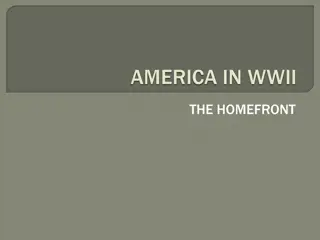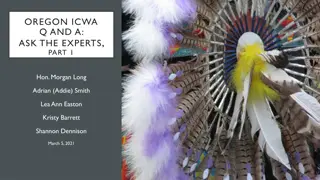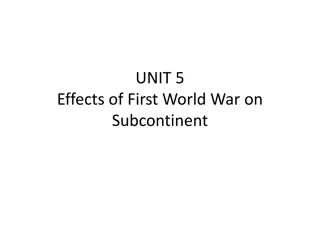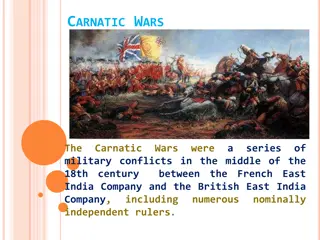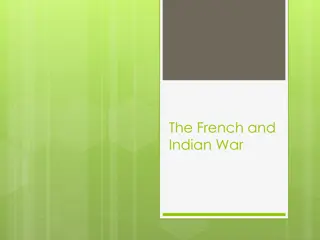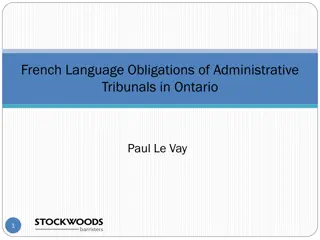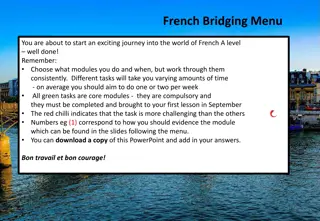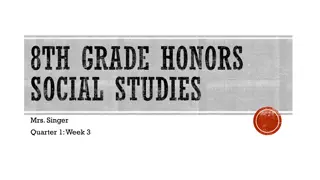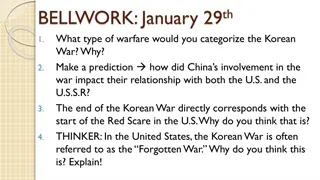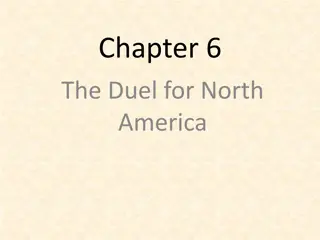Unveiling the French and Indian War
Trouble arose as Native Americans contested British control, leading to the Proclamation of 1763 restricting colonial settlement. Resentment grew, fueling Pontiac's Rebellion where various tribes, led by Pontiac, fought British forces. Native American warriors attacked forts and colonists, capturing Forts Venango and Le Boeuf. Fort Pitt faced a siege by Delaware Indians in June 1763.
Download Presentation

Please find below an Image/Link to download the presentation.
The content on the website is provided AS IS for your information and personal use only. It may not be sold, licensed, or shared on other websites without obtaining consent from the author.If you encounter any issues during the download, it is possible that the publisher has removed the file from their server.
You are allowed to download the files provided on this website for personal or commercial use, subject to the condition that they are used lawfully. All files are the property of their respective owners.
The content on the website is provided AS IS for your information and personal use only. It may not be sold, licensed, or shared on other websites without obtaining consent from the author.
E N D
Presentation Transcript
Working with your partner, write a summary of the French and Indian War. You can t talk and you have to take turns writing every other word. You have two minutes to write your summary.
Knowing that there could be trouble with Native Americans still living in the new area now controlled by England, Parliament needed a way to control their colonists and new territory.
The Proclamation of 1763 was given which created a line along the frontier. Colonists were not to settle on land west of the Proclamation Line of 1763. File:Map of territorial growth 1775.svg
Native Americans living in the Great Lakes region and Ohio River Valley did not like the way they were being treated by the British and were afraid their land would be taken away.
Many Native American tribes joined together to fight the British and colonists. One of the main leaders was an Ottawa named Pontiac. The fighting that followed is called Pontiac s War or Pontiac s Rebellion.
Read the biography about Pontiac on pg.159 in your social studies textbook and answer the following question. How did Pontiac s ability to persuade people help him organize a rebellion?
Native American warriors attacked forts, destroyed farms in the frontier, and killed many colonists living on the frontier.
Fort Venango (Franklin) and Fort Le Boeuf (Waterford) were captured by Native Americans in June of 1763.
Fort Pitt was attacked by Delaware Indians on June 22,1763. They couldn t capture the fort, so they laid siege to it.
Many people from the area had fled to Fort Pitt for protection from Native American raids. The fort normally only held 300 people. During the siege, over 1,500 people sought shelter there.
Colonel Henry Bouquet of Lancaster, along with 500 soldiers were sent to relieve Fort Pitt. The Delawares laying siege to the fort left it to attack Bouquet s men.
The two forces clashed on August 5, 1763, and fought the Battle of Bushy Run for two days.
Bouquet and his men won, relieved Fort Pitt, and ended Pontiac s War in Pennsylvania and the surrounding area. The war officially ended on July 25, 1766.
CINQUAIN Use the following format to write a cinquain poem about Pontiac s Rebellion. Line 1- one word/ subject Line 2- two adjectives describing line one Line 3- three action verbs that relate to line one Line 4- a four-word sentence that relates to line one Line 5- one word that is a synonym of line one
Example of a Cinquain Students Students Inquisitive, thoughtful Inquisitive, thoughtful Reading, writing, thinking Reading, writing, thinking Working hard to succeed Working hard to succeed Pupils Pupils







